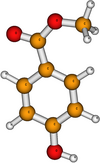| Revision as of 21:26, 12 March 2024 editTautropfli (talk | contribs)149 editsm Use of Unbulleted list macro for OtherNames property of Chembox as is the recommendation in the docs.Tag: 2017 wikitext editor← Previous edit | Latest revision as of 17:49, 11 September 2024 edit undoCitation bot (talk | contribs)Bots5,433,512 edits Added bibcode. | Use this bot. Report bugs. | Suggested by Abductive | Category:E-number additives | #UCB_Category 290/313 | ||
| Line 79: | Line 79: | ||
| Methylparaben is readily absorbed from the gastrointestinal tract or through the skin.<ref name="Soni">{{cite journal | vauthors = Soni MG, Taylor SL, Greenberg NA, Burdock GA | title = Evaluation of the health aspects of methyl paraben: a review of the published literature | journal = Food and Chemical Toxicology | volume = 40 | issue = 10 | pages = 1335–73 | date = October 2002 | pmid = 12387298 | doi = 10.1016/S0278-6915(02)00107-2 }}</ref> It is ] to ] and rapidly excreted in urine without accumulating in the body.<ref name="Soni"/> Acute toxicity studies have shown that methylparaben is practically non-toxic by both oral and ] administration in animals.<ref name="Soni"/> In a population with normal skin, methylparaben is practically non-irritating and non-sensitizing; however, allergic reactions to ingested parabens have been reported.<ref name="Soni"/> A 2008 study found no competitive binding for human estrogen and androgen receptors for methylparaben, but varying levels of competitive binding were seen with butyl- and isobutyl-paraben.<ref>{{cite journal | vauthors = Alan AF | title = Final amended report on the safety assessment of Methylparaben, Ethylparaben, Propylparaben, Isopropylparaben, Butylparaben, Isobutylparaben, and Benzylparaben as used in cosmetic products | journal = International Journal of Toxicology | volume = 27 Suppl 4 | issue = Suppl 4 | pages = 1–82 | date = 2008 | pmid = 19101832 | doi = 10.1080/10915810802548359 }}</ref> | Methylparaben is readily absorbed from the gastrointestinal tract or through the skin.<ref name="Soni">{{cite journal | vauthors = Soni MG, Taylor SL, Greenberg NA, Burdock GA | title = Evaluation of the health aspects of methyl paraben: a review of the published literature | journal = Food and Chemical Toxicology | volume = 40 | issue = 10 | pages = 1335–73 | date = October 2002 | pmid = 12387298 | doi = 10.1016/S0278-6915(02)00107-2 }}</ref> It is ] to ] and rapidly excreted in urine without accumulating in the body.<ref name="Soni"/> Acute toxicity studies have shown that methylparaben is practically non-toxic by both oral and ] administration in animals.<ref name="Soni"/> In a population with normal skin, methylparaben is practically non-irritating and non-sensitizing; however, allergic reactions to ingested parabens have been reported.<ref name="Soni"/> A 2008 study found no competitive binding for human estrogen and androgen receptors for methylparaben, but varying levels of competitive binding were seen with butyl- and isobutyl-paraben.<ref>{{cite journal | vauthors = Alan AF | title = Final amended report on the safety assessment of Methylparaben, Ethylparaben, Propylparaben, Isopropylparaben, Butylparaben, Isobutylparaben, and Benzylparaben as used in cosmetic products | journal = International Journal of Toxicology | volume = 27 Suppl 4 | issue = Suppl 4 | pages = 1–82 | date = 2008 | pmid = 19101832 | doi = 10.1080/10915810802548359 }}</ref> | ||
| Studies indicate that methylparaben applied on the skin may react with ], leading to increased skin aging and DNA damage.<ref>{{cite journal | vauthors = Handa O, Kokura S, Adachi S, Takagi T, Naito Y, Tanigawa T, Yoshida N, Yoshikawa T | display-authors = 6 | title = Methylparaben potentiates UV-induced damage of skin keratinocytes | journal = Toxicology | volume = 227 | issue = 1–2 | pages = 62–72 | date = October 2006 | pmid = 16938376 | doi = 10.1016/j.tox.2006.07.018 }}</ref><ref>{{cite journal | vauthors = Okamoto Y, Hayashi T, Matsunami S, Ueda K, Kojima N | title = Combined activation of methyl paraben by light irradiation and esterase metabolism toward oxidative DNA damage | journal = Chemical Research in Toxicology | volume = 21 | issue = 8 | pages = 1594–9 | date = August 2008 | pmid = 18656963 | doi = 10.1021/tx800066u }}</ref> | Studies indicate that methylparaben applied on the skin may react with ], leading to increased skin aging and DNA damage.<ref>{{cite journal | vauthors = Handa O, Kokura S, Adachi S, Takagi T, Naito Y, Tanigawa T, Yoshida N, Yoshikawa T | display-authors = 6 | title = Methylparaben potentiates UV-induced damage of skin keratinocytes | journal = Toxicology | volume = 227 | issue = 1–2 | pages = 62–72 | date = October 2006 | pmid = 16938376 | doi = 10.1016/j.tox.2006.07.018 | bibcode = 2006Toxgy.227...62H }}</ref><ref>{{cite journal | vauthors = Okamoto Y, Hayashi T, Matsunami S, Ueda K, Kojima N | title = Combined activation of methyl paraben by light irradiation and esterase metabolism toward oxidative DNA damage | journal = Chemical Research in Toxicology | volume = 21 | issue = 8 | pages = 1594–9 | date = August 2008 | pmid = 18656963 | doi = 10.1021/tx800066u }}</ref> | ||
| == References == | == References == | ||
Latest revision as of 17:49, 11 September 2024
Chemical compound
| |||
| Names | |||
|---|---|---|---|
| Preferred IUPAC name Methyl 4-hydroxybenzoate | |||
Other names
| |||
| Identifiers | |||
| CAS Number | |||
| 3D model (JSmol) | |||
| ChEBI | |||
| ChEMBL | |||
| ChemSpider | |||
| ECHA InfoCard | 100.002.532 | ||
| E number | E218 (preservatives) | ||
| IUPHAR/BPS | |||
| KEGG | |||
| PubChem CID | |||
| UNII | |||
| CompTox Dashboard (EPA) | |||
InChI
| |||
SMILES
| |||
| Properties | |||
| Chemical formula | C8H8O3 | ||
| Molar mass | 152.149 g·mol | ||
| Appearance | Colorless crystals or white crystalline powder | ||
| UV-vis (λmax) | 255 nm (methanol) | ||
| Magnetic susceptibility (χ) | −88.7·10 cm/mol | ||
| Hazards | |||
| NFPA 704 (fire diamond) |
 | ||
| Related compounds | |||
| Related Parabens | Ethylparaben Propylparaben Butylparaben | ||
| Related compounds | Methyl salicylate (ortho isomer) | ||
| Except where otherwise noted, data are given for materials in their standard state (at 25 °C , 100 kPa).
| |||

Methylparaben (methyl paraben) one of the parabens, is a preservative with the chemical formula CH3(C6H4(OH)COO). It is the methyl ester of p-hydroxybenzoic acid.
Natural occurrences
Methylparaben serves as a pheromone for a variety of insects and is a component of queen mandibular pheromone.
It is a pheromone in wolves produced during estrus associated with the behavior of alpha male wolves preventing other males from mounting females in heat.
Uses
Methylparaben is an anti-fungal agent often used in a variety of cosmetics and personal-care products. It is also used as a food preservative and has the E number E218.
Methylparaben is commonly used as a fungicide in Drosophila food media at 0.1%. To Drosophila, methylparaben is toxic at higher concentrations, has an estrogenic effect (mimicking estrogen in rats and having anti-androgenic activity), and slows the growth rate in the larval and pupal stages at 0.2%.
Safety
There is controversy about whether methylparaben or propylparabens are harmful at concentrations typically used in body care or cosmetics. Methylparaben and propylparaben are considered generally recognized as safe (GRAS) by the USFDA for food and cosmetic antibacterial preservation. Methylparaben is readily metabolized by common soil bacteria, making it completely biodegradable.
Methylparaben is readily absorbed from the gastrointestinal tract or through the skin. It is hydrolyzed to p-hydroxybenzoic acid and rapidly excreted in urine without accumulating in the body. Acute toxicity studies have shown that methylparaben is practically non-toxic by both oral and parenteral administration in animals. In a population with normal skin, methylparaben is practically non-irritating and non-sensitizing; however, allergic reactions to ingested parabens have been reported. A 2008 study found no competitive binding for human estrogen and androgen receptors for methylparaben, but varying levels of competitive binding were seen with butyl- and isobutyl-paraben.
Studies indicate that methylparaben applied on the skin may react with UVB, leading to increased skin aging and DNA damage.
References
- "Methylparaben Experimental Properties". PubChem.
- "Semiochemical - me-4-hydroxybenzoate". pherobase.com.
- Mertl-Millhollen, Anne S.; Goodmann, Patricia A.; Klinghammer, Erich (1986). "Wolf scent marking with raised-leg urination". Zoo Biology. 5: 7–20. doi:10.1002/zoo.1430050103.
- Steven R. Lindsay (2013). Handbook of Applied Dog Behavior and Training, Adaptation and Learning. John Wiley and Sons.
- "Bloomington Drosophila Stock Center".
- Gu W, Xie DJ, Hour XW (2009). "Toxicity and Estrogen Effects of Methyl Paraben on Drosophila melanogaster". Food Science. 30 (1): 252–254.
- "Parabens". Food and Drug Administration. 9 September 2020.
- ^ Soni MG, Taylor SL, Greenberg NA, Burdock GA (October 2002). "Evaluation of the health aspects of methyl paraben: a review of the published literature". Food and Chemical Toxicology. 40 (10): 1335–73. doi:10.1016/S0278-6915(02)00107-2. PMID 12387298.
- Alan AF (2008). "Final amended report on the safety assessment of Methylparaben, Ethylparaben, Propylparaben, Isopropylparaben, Butylparaben, Isobutylparaben, and Benzylparaben as used in cosmetic products". International Journal of Toxicology. 27 Suppl 4 (Suppl 4): 1–82. doi:10.1080/10915810802548359. PMID 19101832.
- Handa O, Kokura S, Adachi S, Takagi T, Naito Y, Tanigawa T, et al. (October 2006). "Methylparaben potentiates UV-induced damage of skin keratinocytes". Toxicology. 227 (1–2): 62–72. Bibcode:2006Toxgy.227...62H. doi:10.1016/j.tox.2006.07.018. PMID 16938376.
- Okamoto Y, Hayashi T, Matsunami S, Ueda K, Kojima N (August 2008). "Combined activation of methyl paraben by light irradiation and esterase metabolism toward oxidative DNA damage". Chemical Research in Toxicology. 21 (8): 1594–9. doi:10.1021/tx800066u. PMID 18656963.
External links
- Methylparaben at Hazardous Substances Data Bank
- Methylparaben Archived 2017-05-01 at the Wayback Machine at Household Products Database
- European Commission Scientific Committee on Consumer Products Extended Opinion on the Safety Evaluation of Parabens (2005)
| Phenolic acids (C6-C1) and their glycosides | |||||
|---|---|---|---|---|---|
| Monohydroxybenzoic acids |
| ||||
| Dihydroxybenzoic acids |
| ||||
| Trihydroxybenzoic acids |
| ||||

